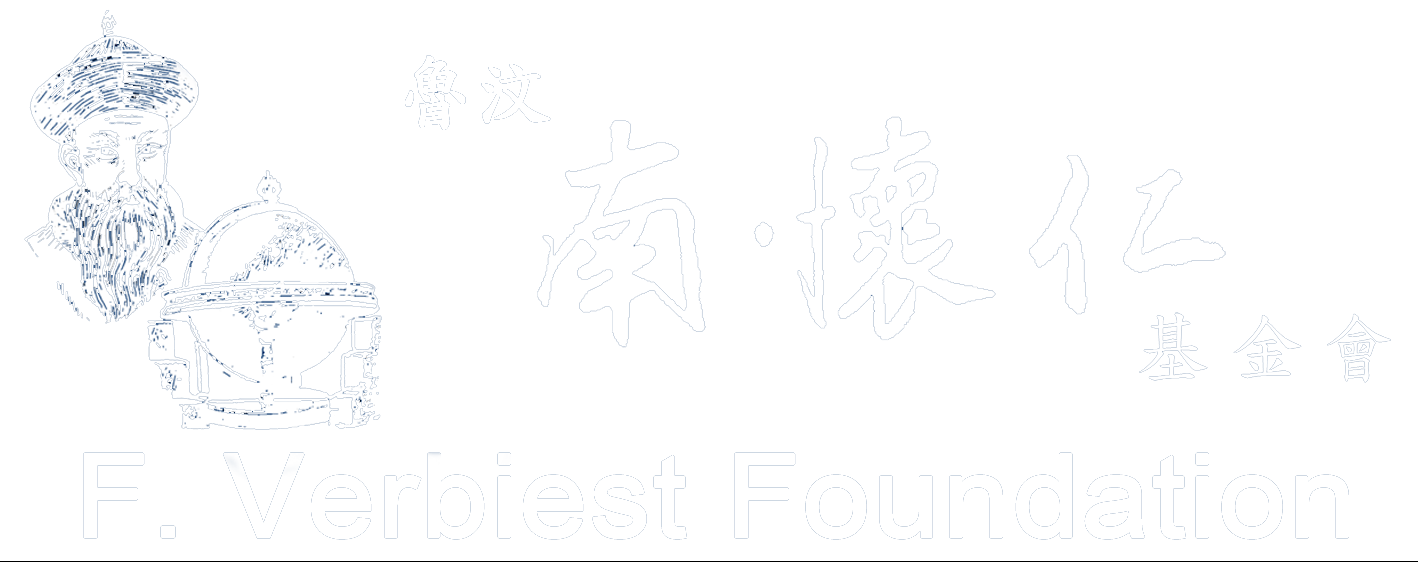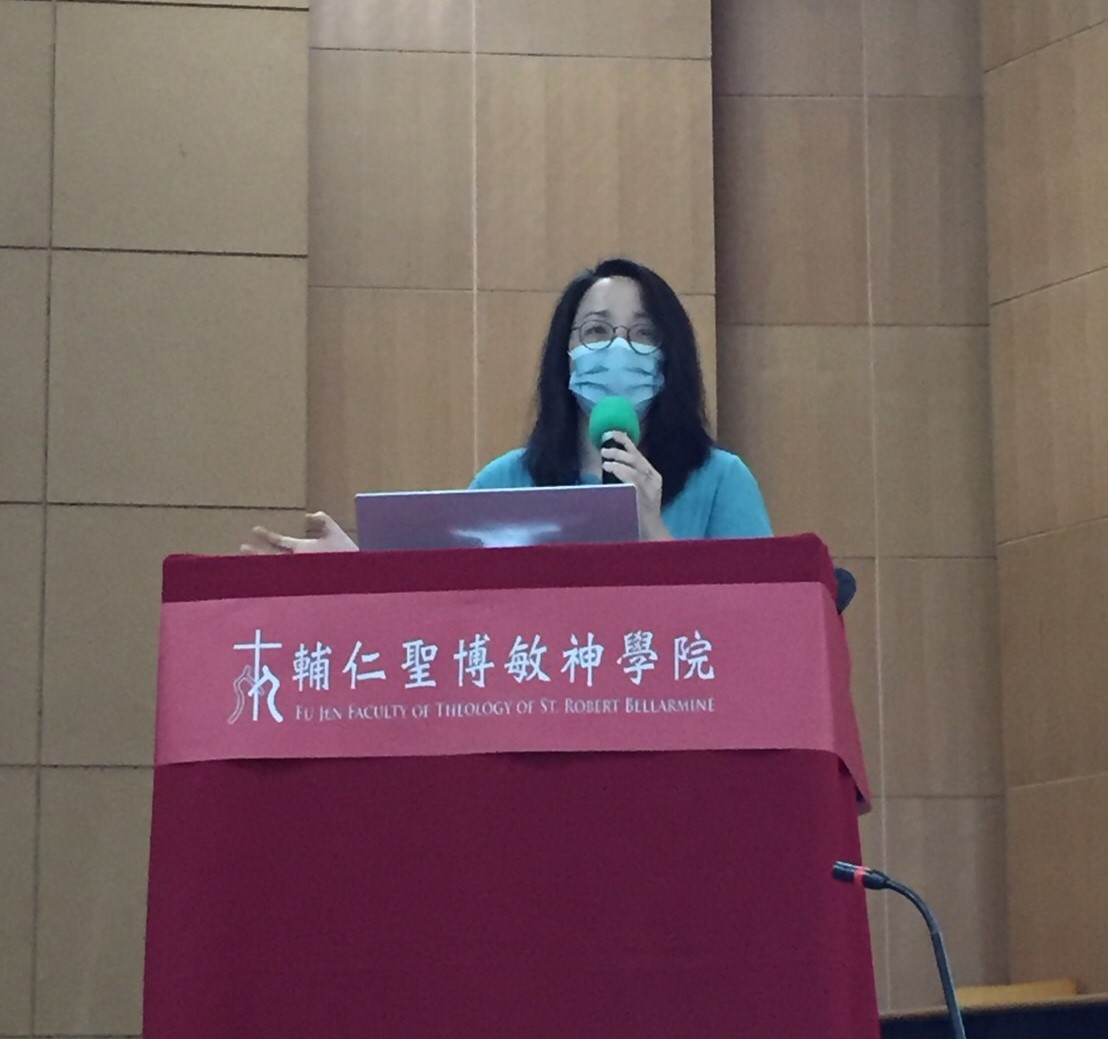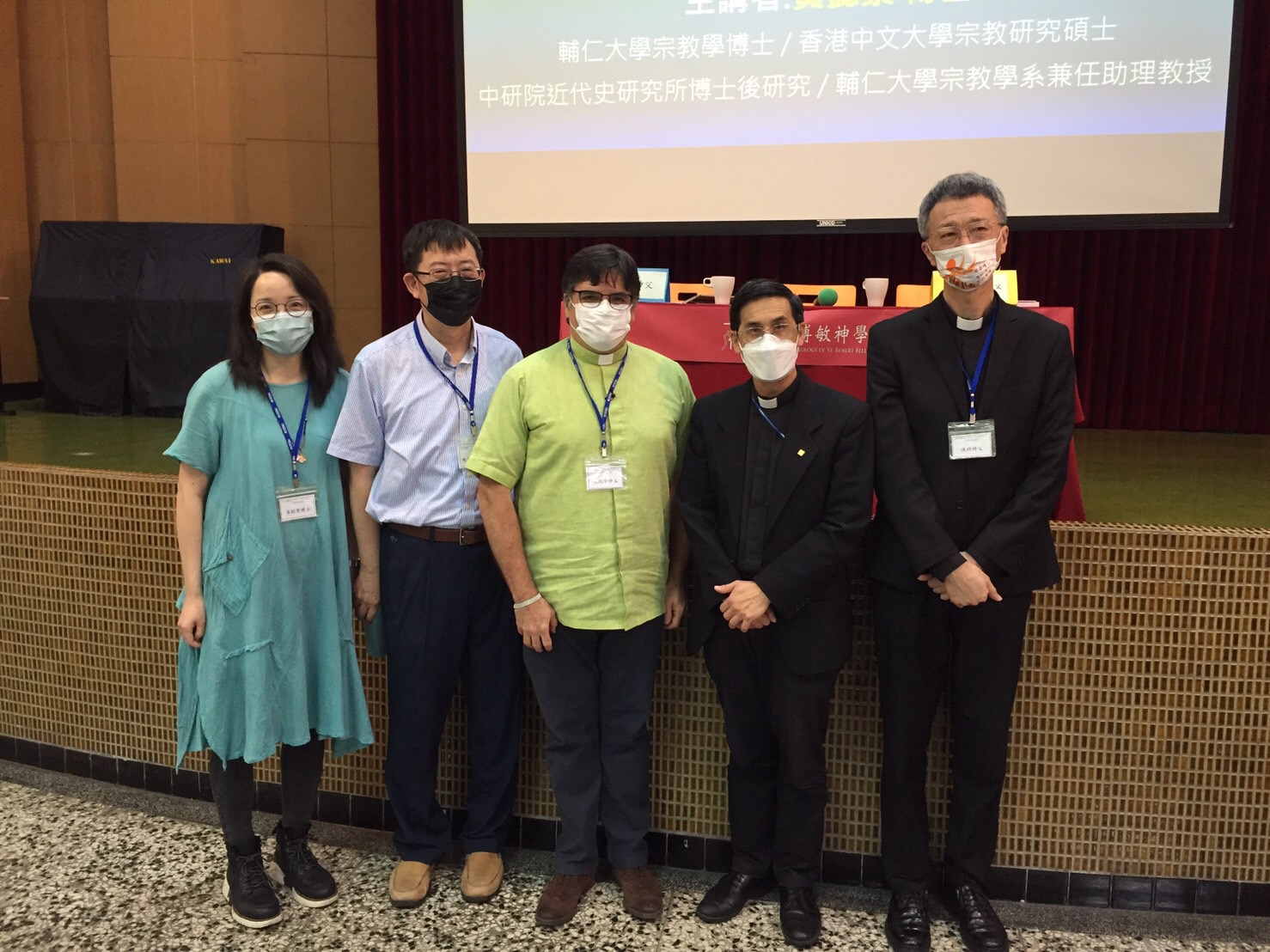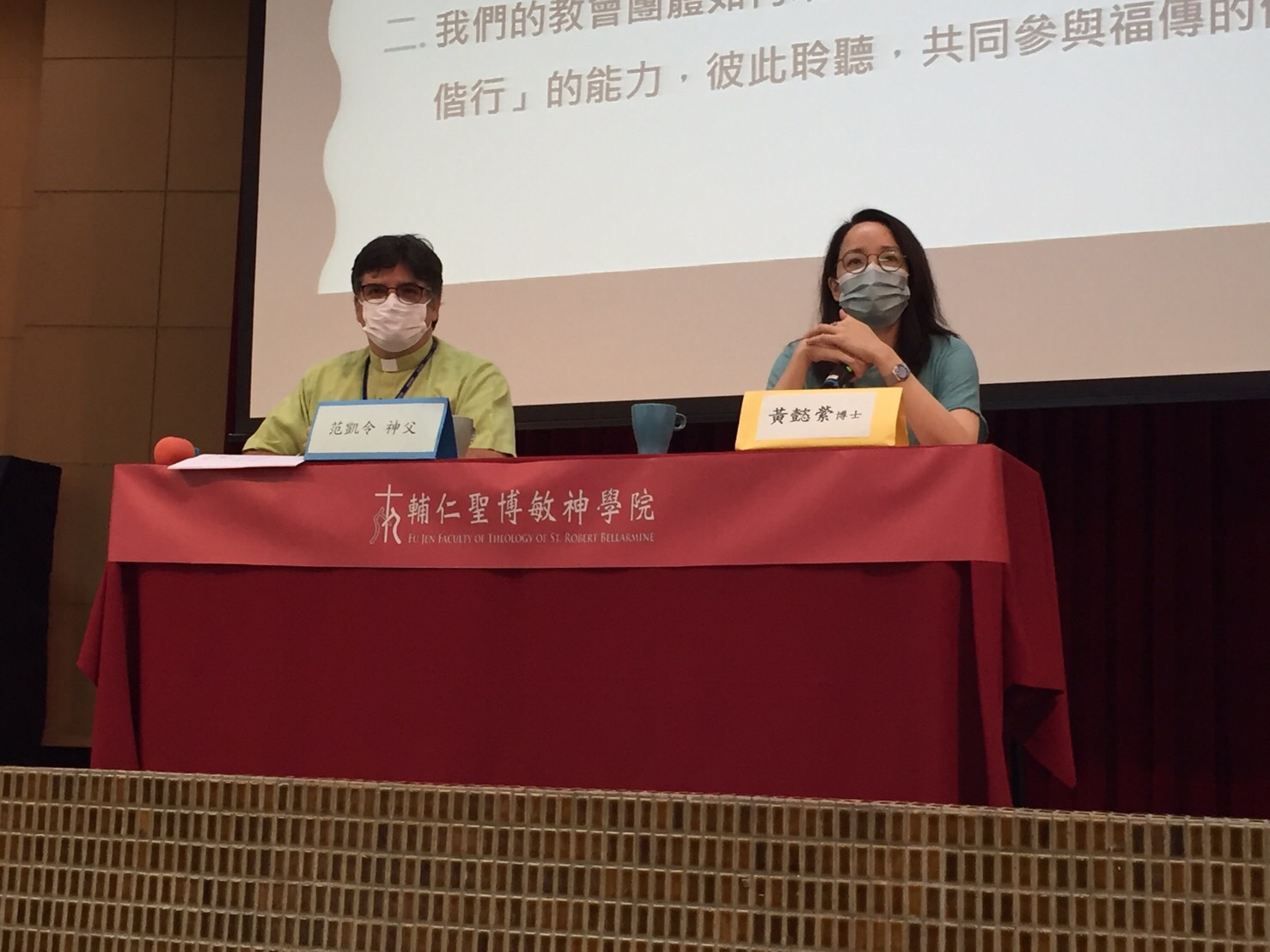"Fu Jen Faculty of Theology of St. Robert Bellarmine" and Chinese Ferdinand Verbiest Cultural Association" co-hosted the 4th Workshop in the Spirituality of Dialogue on May 28, 2022 (Saturday) - "For a Synodal Church: Communion, Participation and Mission" at the premises of St. Robert Bellarmine Faculty of Theology. After the initial prayer and the opening speeches, the workshop went ahead with the presentations of Fr. Jeffrey Chang (Dean of St. Robert Bellarmine Faculty of Theology and Director of Master studies) on "A Synodal Church: United in Christ, Walking in the Spirit", and Fr. Otfried Chan (Secretary General of the Secretariat of the Catholic Church Taiwan Bishops' Conference) on "Synodal Spirituality". Both presentations invited us to see this synod as an opportunity to renew and transform our Christian life by meeting, listening and discerning in communion with different people.
The Influence of Modern Era Synods and Catholic lay people on Catholic Missionary Activities in China For the last part of the morning Dr. Bibiana Yee-ying Wong gave a lecture on "Synodality in Church History: Meetings of Bishops, Formation of the Laity and Lay Apostolate in Modern China”. Dr. Wong holds a Master of Religious Studies from the Chinese University of Hong Kong and a Ph.D. in Religious Studies from Fu Jen Catholic University. She was an associate editor of the Hong Kong branch of the Catholic Asia News Agency, and she is currently a postdoctoral researcher at Academia Sinica’s Institute of Modern History, and part-time assistant professor at the Department of Religious Studies, Fu Jen Catholic University. Her main fields of research and expertise are Catholic history of Modern China, Sino-Vatican relations, and religion and politics. The topic presented by Dr. Wong is closely related to her doctoral dissertation research on the Chinese Catholic Bureau.
Dr. Wong approached the topic from the historical perspective of the different Bishop Meetings that happened in modern China, including the Jiading Conference (1627 [Ming Dynasty]), the Sichuan Conference (1803 [Qing Dynasty]), the Shanghai Conference (1851), and the Meetings of the Five Missionary Regions. From the standpoint of the role of Chinese lay believers, Dr. Wong revisited these events, and analyzed their impact on the Catholic missionary activities in China.
Dr. Wong also specifically mentioned the role of Chinese Catholics in the late Ming Dynasty, including writing books, assisting foreign missionaries in translation, building churches and missionary residences, inviting missionaries to teach in their hometowns, and writing favorable letters to the imperial court to protect the Church on occasion of religious incidents. In the late Ming and early Qing dynasties, without the assistance of the faithful, the foreign missionaries would have not been able to spread the gospel locally as they did.
However, in later times, the educational level of the faithful and their participation in missionary activities did not match up former ones. After the Rites Controversy in the late Qing Dynasty, Catholic missionary activity mainly targeted poor peasants, and missionaries set up catechetical schools in the larger villages, teaching catholic catechism and training missionary assistants. As a consequence, the education level of most ordinary Catholics was low and their role was not appreciated neither by the church nor by society. Before the May 4th Movement (1919), there was only one Catholic university: Shanghai Aurora Academy (1903) established by the Society of Jesus. This lack of Catholic institutions of major education in China is an indication that the cultivation of the Catholic faithful was not taken seriously at the time and, by then, lay people mostly played a passive role in missionary activities.
Important figures in promoting Catholic reform in the 20th century: Ma Xiangbo, Ying Lianzhi, Lei Mingyuan
In her lecture, Dr. Bibiana Wong introduced three pioneer missionaries of the late Qing Dynasty and the early Republic of China: Ma Xiangbo, Ying Lianzhi, and Vincent Lebbe. Dr. Wong first introduced the figure of Father Vincent Lebbe, a Belgian member of the Congregation of the Mission (CM, Lazarists). In order to spread Catholicism among city dwellers, he promoted the creation of western style Catholic primary schools in urban areas. In 1909 he established a Mission Society to encourage the faithful to join in missionary work and to boost the Church’s social and cultural influence. After that, he worked with priests in Shanxi, Shanghai and other places to promote Catholic Action. As newspapers were considered a very effective media at that time, Father Lebbe with the support of Vincent Lianzhi Ying (a Catholic Manchu aristocrat and founder of the newspaper “Ta Kung Pao”) founded in 1912 the weekly newspaper "Guangyilu", and in 1915 published the first Catholic Chinese daily "Yishibao" to promote patriotism and religion to save the nation. In 1916, Fathers Lebbe and Antoine Cotta, a Lazarist confrere, were punished by their superior for supporting the people in Tianjin in their protest against the expansion of the French Concession (Laoxikai Incident). The two jointly wrote a letter to the Holy See, expressing their views on the problems of the Chinese church, mentioning among others, that the strong European character of the Chinese church, the deficient formation of the local priesthood, and the lack of cooperation among the various foreign missionary congregations. Dr. Bibiana Wong then introduced the figure of Joseph Xiangbo Ma, the founder of Aurora Academy and Fudan University. In 1910, Joseph Ma became acquainted too with Vincent Ying, and became friends for life. Among the few Chinese Catholic intellectuals of that time, they were concerned on devising ways the Catholic church could improve the educational background of the faithful and priests. Therefore in 1912, they wrote a letter to the Holy See requesting the establishment of a Catholic university in China. In 1917, Vincent Ying published the pamphlet "A Humble Proposal on the Exhortation to Learning" (勸學罪言) criticizing the attitude of many foreign missionaries as imperialist, disrespectful towards Chinese culture, and opposed to the academic advancement of Chinese Catholic faithful and priests. All this activity called the attention of the Holy See that not only sympathized with their plea and the situation of the Chinese Church, but influenced too Pope Benedict XV’s Pastoral Letter “Maximum Illud” (1919) that stressed the importance of building up the local churches. At the end of this Pastoral Letter, the faithful were encouraged to assist in missionary activities in three ways: praying God to assist the missionaries, cultivating missionary vocations, and supporting missionary undertakings with financial resources.
The Republic of China period: Catholics join bishops and priests in spreading the Gospel of Christ
One of the relevant outcomes of the Pastoral Letter "Maximum Illud" for the Church in China is that Pope Pius XI appointed Archbishop Celso Benigno Luigi Costantini as the first Apostolic Delegate to China. With great determination, Arch. Costantini promoted a series of Church reforms aimed at ending the French patronage over the Chinese Catholic Church on one side, and establishing Chinese Catholic hierarchy and local churches on the other. According to Dr. Wong, Arch. Costantini's first task after taking office in 1922 was to prepare the First Plenary Meeting of Chinese Bishops, the 1924 Chinese (Catholic) National Council. Despite the opposition of some missionaries during the meeting, Bp. Costantini got approved the motion supporting the revitalization of Catholic Action. Four years later (1928), seeing the Pope efforts in Europe to promote it, Costantini drafted the provisional constitution of the Chinese Catholic Action and submitted it The Holy See. Soon after, the Pope sent a congratulatory message to the Nanjing Nationalist Government, which had succeeded in the Northern Expedition, and encouraged the heads of the dioceses to promote Catholic Action in their dioceses, so that the faithful could better contribute to the country and assist bishops and priests in spreading the Gospel.
The Catholic Church flourished in China in the 1930s, although its activities gradually ceased during the Japanese invasion and then the war on China. Still, after the war, the active role of the Catholic faithful in missionary activities recovered fast and continued developing. Archbishop Antonio Riberi, appointed as Holy See Nuncio to China in 1946, vigorously promoted the Legion of Mary, and appointed Father William Aedan McGrath, an Irish national, and Chinese Father Joseph Shixian Shen, as assistant. In just two years -from 1948 to 1950, more than 1,000 groups of the Legion of Mary were established throughout more than 90 dioceses, promoting the revitalization of Catholic faith in the parishes. When the missionaries were unable to move freely, the Legion members helped to visit the families of the faithful, conveyed the stance and instructions of the church authorities, and strengthened the faith of the faithful.
Synodality from the history of Chinese people's reception of the Gospel
 Dr. Bibiana Wong emphasized in her final wrap-up that Catholicism has been present in China since the late Ming Dynasty, already more than 400 years. The number of Chinese who accepted the Gospel was small at first, but many were highly educated and had social influence, which was extremely helpful for missionary work and the advancement of the encounter between Christian faith and Chinese tradition. By the late Qing Dynasty, mission work and the Catholic Church profited from the protection given by the unequal treaties, but it was a double-edged sword. Although the number of people accepting baptism and joining the church increased greatly, most of them were poor peasants, and some were even crooks who wanted to take advantage of the missionaries’ authority. Therefore, intellectuals (usually among the gentry class) were reluctant to be seen in their company, and they even denounced missionary activities as cultural aggression by Western imperialism.
Dr. Bibiana Wong emphasized in her final wrap-up that Catholicism has been present in China since the late Ming Dynasty, already more than 400 years. The number of Chinese who accepted the Gospel was small at first, but many were highly educated and had social influence, which was extremely helpful for missionary work and the advancement of the encounter between Christian faith and Chinese tradition. By the late Qing Dynasty, mission work and the Catholic Church profited from the protection given by the unequal treaties, but it was a double-edged sword. Although the number of people accepting baptism and joining the church increased greatly, most of them were poor peasants, and some were even crooks who wanted to take advantage of the missionaries’ authority. Therefore, intellectuals (usually among the gentry class) were reluctant to be seen in their company, and they even denounced missionary activities as cultural aggression by Western imperialism.
After the First World War, the Holy See was determined to renovate overseas missionary activities, to remove the interference of extraneous forces on the church mission, and to encourage the faithful to take part in missionary work.
After the Second Vatican Council (1962-1965), the local Chinese church and hierarchy was gradually attained thanks to the constant efforts of lay, priests and bishops, and the role of the laity in the Chinese church has been reaffirmed and appreciated.
Today, Pope Francis advocates a spirit of synodality for the Universal Church and invites the faithful to join the Universal Synod of Bishops. Our church community should also think about how to nurture the faithful, so that we all can enhance our “synodal abilities”, listen to each other, and participate together in our common mission of spreading the Gospel.
Video broadcast on YouTube network platform
The video content of the session by Dr. Bibiana Wong is hosted on the “Voice of the Catholic Church” YouTube online platform (Mandarin language). Readers are welcome to visit Verbiest Foundation website (in Chinese) for the broadcast and other info.
The Influence of Modern Era Synods and Catholic lay people on Catholic Missionary Activities in China For the last part of the morning Dr. Bibiana Yee-ying Wong gave a lecture on "Synodality in Church History: Meetings of Bishops, Formation of the Laity and Lay Apostolate in Modern China”. Dr. Wong holds a Master of Religious Studies from the Chinese University of Hong Kong and a Ph.D. in Religious Studies from Fu Jen Catholic University. She was an associate editor of the Hong Kong branch of the Catholic Asia News Agency, and she is currently a postdoctoral researcher at Academia Sinica’s Institute of Modern History, and part-time assistant professor at the Department of Religious Studies, Fu Jen Catholic University. Her main fields of research and expertise are Catholic history of Modern China, Sino-Vatican relations, and religion and politics. The topic presented by Dr. Wong is closely related to her doctoral dissertation research on the Chinese Catholic Bureau.
Dr. Wong approached the topic from the historical perspective of the different Bishop Meetings that happened in modern China, including the Jiading Conference (1627 [Ming Dynasty]), the Sichuan Conference (1803 [Qing Dynasty]), the Shanghai Conference (1851), and the Meetings of the Five Missionary Regions. From the standpoint of the role of Chinese lay believers, Dr. Wong revisited these events, and analyzed their impact on the Catholic missionary activities in China.
Dr. Wong also specifically mentioned the role of Chinese Catholics in the late Ming Dynasty, including writing books, assisting foreign missionaries in translation, building churches and missionary residences, inviting missionaries to teach in their hometowns, and writing favorable letters to the imperial court to protect the Church on occasion of religious incidents. In the late Ming and early Qing dynasties, without the assistance of the faithful, the foreign missionaries would have not been able to spread the gospel locally as they did.
However, in later times, the educational level of the faithful and their participation in missionary activities did not match up former ones. After the Rites Controversy in the late Qing Dynasty, Catholic missionary activity mainly targeted poor peasants, and missionaries set up catechetical schools in the larger villages, teaching catholic catechism and training missionary assistants. As a consequence, the education level of most ordinary Catholics was low and their role was not appreciated neither by the church nor by society. Before the May 4th Movement (1919), there was only one Catholic university: Shanghai Aurora Academy (1903) established by the Society of Jesus. This lack of Catholic institutions of major education in China is an indication that the cultivation of the Catholic faithful was not taken seriously at the time and, by then, lay people mostly played a passive role in missionary activities.
Important figures in promoting Catholic reform in the 20th century: Ma Xiangbo, Ying Lianzhi, Lei Mingyuan
In her lecture, Dr. Bibiana Wong introduced three pioneer missionaries of the late Qing Dynasty and the early Republic of China: Ma Xiangbo, Ying Lianzhi, and Vincent Lebbe. Dr. Wong first introduced the figure of Father Vincent Lebbe, a Belgian member of the Congregation of the Mission (CM, Lazarists). In order to spread Catholicism among city dwellers, he promoted the creation of western style Catholic primary schools in urban areas. In 1909 he established a Mission Society to encourage the faithful to join in missionary work and to boost the Church’s social and cultural influence. After that, he worked with priests in Shanxi, Shanghai and other places to promote Catholic Action. As newspapers were considered a very effective media at that time, Father Lebbe with the support of Vincent Lianzhi Ying (a Catholic Manchu aristocrat and founder of the newspaper “Ta Kung Pao”) founded in 1912 the weekly newspaper "Guangyilu", and in 1915 published the first Catholic Chinese daily "Yishibao" to promote patriotism and religion to save the nation. In 1916, Fathers Lebbe and Antoine Cotta, a Lazarist confrere, were punished by their superior for supporting the people in Tianjin in their protest against the expansion of the French Concession (Laoxikai Incident). The two jointly wrote a letter to the Holy See, expressing their views on the problems of the Chinese church, mentioning among others, that the strong European character of the Chinese church, the deficient formation of the local priesthood, and the lack of cooperation among the various foreign missionary congregations. Dr. Bibiana Wong then introduced the figure of Joseph Xiangbo Ma, the founder of Aurora Academy and Fudan University. In 1910, Joseph Ma became acquainted too with Vincent Ying, and became friends for life. Among the few Chinese Catholic intellectuals of that time, they were concerned on devising ways the Catholic church could improve the educational background of the faithful and priests. Therefore in 1912, they wrote a letter to the Holy See requesting the establishment of a Catholic university in China. In 1917, Vincent Ying published the pamphlet "A Humble Proposal on the Exhortation to Learning" (勸學罪言) criticizing the attitude of many foreign missionaries as imperialist, disrespectful towards Chinese culture, and opposed to the academic advancement of Chinese Catholic faithful and priests. All this activity called the attention of the Holy See that not only sympathized with their plea and the situation of the Chinese Church, but influenced too Pope Benedict XV’s Pastoral Letter “Maximum Illud” (1919) that stressed the importance of building up the local churches. At the end of this Pastoral Letter, the faithful were encouraged to assist in missionary activities in three ways: praying God to assist the missionaries, cultivating missionary vocations, and supporting missionary undertakings with financial resources.
The Republic of China period: Catholics join bishops and priests in spreading the Gospel of Christ
One of the relevant outcomes of the Pastoral Letter "Maximum Illud" for the Church in China is that Pope Pius XI appointed Archbishop Celso Benigno Luigi Costantini as the first Apostolic Delegate to China. With great determination, Arch. Costantini promoted a series of Church reforms aimed at ending the French patronage over the Chinese Catholic Church on one side, and establishing Chinese Catholic hierarchy and local churches on the other. According to Dr. Wong, Arch. Costantini's first task after taking office in 1922 was to prepare the First Plenary Meeting of Chinese Bishops, the 1924 Chinese (Catholic) National Council. Despite the opposition of some missionaries during the meeting, Bp. Costantini got approved the motion supporting the revitalization of Catholic Action. Four years later (1928), seeing the Pope efforts in Europe to promote it, Costantini drafted the provisional constitution of the Chinese Catholic Action and submitted it The Holy See. Soon after, the Pope sent a congratulatory message to the Nanjing Nationalist Government, which had succeeded in the Northern Expedition, and encouraged the heads of the dioceses to promote Catholic Action in their dioceses, so that the faithful could better contribute to the country and assist bishops and priests in spreading the Gospel.
The Catholic Church flourished in China in the 1930s, although its activities gradually ceased during the Japanese invasion and then the war on China. Still, after the war, the active role of the Catholic faithful in missionary activities recovered fast and continued developing. Archbishop Antonio Riberi, appointed as Holy See Nuncio to China in 1946, vigorously promoted the Legion of Mary, and appointed Father William Aedan McGrath, an Irish national, and Chinese Father Joseph Shixian Shen, as assistant. In just two years -from 1948 to 1950, more than 1,000 groups of the Legion of Mary were established throughout more than 90 dioceses, promoting the revitalization of Catholic faith in the parishes. When the missionaries were unable to move freely, the Legion members helped to visit the families of the faithful, conveyed the stance and instructions of the church authorities, and strengthened the faith of the faithful.
Synodality from the history of Chinese people's reception of the Gospel
 Dr. Bibiana Wong emphasized in her final wrap-up that Catholicism has been present in China since the late Ming Dynasty, already more than 400 years. The number of Chinese who accepted the Gospel was small at first, but many were highly educated and had social influence, which was extremely helpful for missionary work and the advancement of the encounter between Christian faith and Chinese tradition. By the late Qing Dynasty, mission work and the Catholic Church profited from the protection given by the unequal treaties, but it was a double-edged sword. Although the number of people accepting baptism and joining the church increased greatly, most of them were poor peasants, and some were even crooks who wanted to take advantage of the missionaries’ authority. Therefore, intellectuals (usually among the gentry class) were reluctant to be seen in their company, and they even denounced missionary activities as cultural aggression by Western imperialism.
Dr. Bibiana Wong emphasized in her final wrap-up that Catholicism has been present in China since the late Ming Dynasty, already more than 400 years. The number of Chinese who accepted the Gospel was small at first, but many were highly educated and had social influence, which was extremely helpful for missionary work and the advancement of the encounter between Christian faith and Chinese tradition. By the late Qing Dynasty, mission work and the Catholic Church profited from the protection given by the unequal treaties, but it was a double-edged sword. Although the number of people accepting baptism and joining the church increased greatly, most of them were poor peasants, and some were even crooks who wanted to take advantage of the missionaries’ authority. Therefore, intellectuals (usually among the gentry class) were reluctant to be seen in their company, and they even denounced missionary activities as cultural aggression by Western imperialism.After the First World War, the Holy See was determined to renovate overseas missionary activities, to remove the interference of extraneous forces on the church mission, and to encourage the faithful to take part in missionary work.
After the Second Vatican Council (1962-1965), the local Chinese church and hierarchy was gradually attained thanks to the constant efforts of lay, priests and bishops, and the role of the laity in the Chinese church has been reaffirmed and appreciated.
Today, Pope Francis advocates a spirit of synodality for the Universal Church and invites the faithful to join the Universal Synod of Bishops. Our church community should also think about how to nurture the faithful, so that we all can enhance our “synodal abilities”, listen to each other, and participate together in our common mission of spreading the Gospel.
Video broadcast on YouTube network platform
The video content of the session by Dr. Bibiana Wong is hosted on the “Voice of the Catholic Church” YouTube online platform (Mandarin language). Readers are welcome to visit Verbiest Foundation website (in Chinese) for the broadcast and other info.




